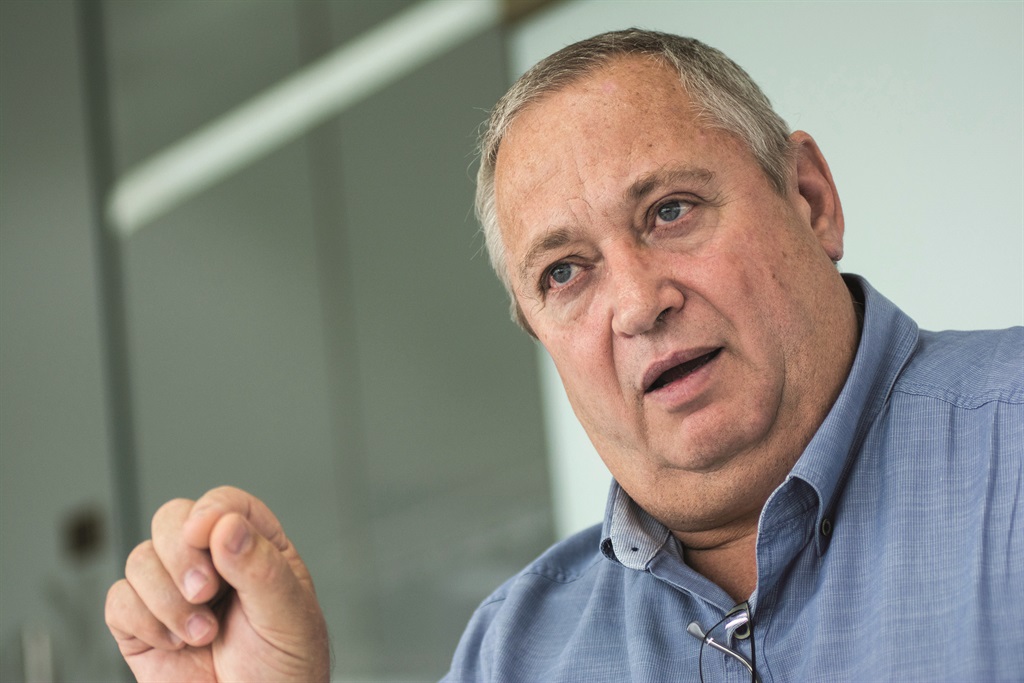On the subject of his firm’s speculated merger with Gold Fields and AngloGold Ashanti, Neal Froneman said: "We have at various points in time made suggestions to all the companies that are relevant in size here in SA and in North America. “He added: “We remain active.”
That may be as detailed as Froneman, the burly, plain-speaking CEO of Sibanye-Stillwater, is prepared to get about this year’s most talked about SA mining sector scuttlebutt: the consolidation of its three largest listed gold firms. Despite all the talk, there’s no actual deal as yet.
Asked whether he would consider a hostile bid for either of Gold Fields or AngloGold Ashanti, Froneman responded: “We think that hostile bids are value destructive. Our board has made it very clear to me that that’s not what we’re going to do.”
Froneman’s comments aside, finweek industry sources say Gold Fields and AngloGold Ashanti have had proposals to combine with Sibanye-Stillwater on their desks since the beginning of the year. Were consolidation of both companies by Sibanye-Stillwater to occur, it would create a 5m-ounce-a-year gold producer with a combined market value of R463bn.
Whilst this valuation is less than Anglo American, which is capitalised in Johannesburg at R781bn, it is nonetheless a number that bears comparison with North American gold peers Newmont Mining and Barrick Gold.
Analysts think such a combination of gold industry heavyweights could happen, but they also believe Froneman’s mere suggestion of the matter publicly, in response to a question at his firm’s annual results announcement in February, was a piece of tree-shaking knavery that could have unintended consequences.
“A takeover of AngloGold or Gold Fields will leave a large gap in the SA-listed gold space,” said Arnold van Graan, an analyst for Nedbank Securities, in a recent note. “We believe there is another alternative that makes plenty of sense from a strategic and valuation perspective: a merger between AngloGold and Gold Fields.”
The idea that AngloGold and Gold Fields could one day combine is old fare in the mining sector. Speculation linking the two has come and fizzled away – an out of reach “holy grail” given the position the two hold in the history of Johannesburg’s founding metal. This time, however, might be different.
Dennis Tucker, the former investment analyst and a corporate financier who is now strategic advisor to Froneman at Sibanye-Stillwater, says the direction of any deal will ultimately be decided by shareholders. “They will decide whatever is the most accretive,” he says.
In the absence of a pre-emptive tie-up between AngloGold and Gold Fields, which would be hard to do given both companies have recently welcomed new top management, time is on Froneman’s side. By going public on possible gold consolidation, he’s been able to compare relative share price performances between his company and AngloGold and Gold Fields.
Valuations
The fact is gold-only companies have performed poorly against Sibanye-Stillwater, which has the benefit of its platinum group metals (PGM) production. The gold price has steadily weakened this year; PGMs – especially its minor metals such as rhodium and iridium – have soared to new heights.
The valuation gap between gold firms and PGMs looks set to widen, if only because macroeconomics has improved, which is generally negative for gold. RBC Capital Markets, for instance, has downgraded its forecast for the gold price. “We now forecast average gold prices of $1 732/oz in 2021, a decrease of 5%, and prices of $1 696/oz in 2022, a decrease of 5%,” said Josh Wolfson, an analyst for the Canadian bank. “The macroeconomic backdrop remains challenging for gold,” said Sophie Spartalis, an analyst for Bank of America (Merrill Lynch, Australia).
Set against this, PGM company ratings are improving. Speaking at the Joburg Indaba’s PGM Industry day, an online conference, Evy Hambro, MD of the giant US investment company BlackRock Inc., said the PGM sector had made such a good fist of debt reduction that the current discount rate applied to its shares was unjustified.
“In our view, PGM producers continue to be underowned,” said Tyler Broda, an analyst for RBC Capital Markets.
Said Citi, an investment bank, in a recent report: “Sibanye-Stillwater has the highest leverage in our coverage with a 10% change in PGM prices resulting in a 19% change in earnings before interest, tax, depreciation and amortisation (ebitda) in our estimates.”
Given the upwards trajectory of PGMs, the premium to gold shares is only likely to widen, making a Sibanye-Stillwater all-share bid for gold consolidation cheaper over time.
“We could sit on our hands and we’ll be a $20bn company in six or nine months’ time (it is currently valued at $13.7bn). We are rerating almost every day and you can see it in the potential of what we’re going to earn this year,” said Froneman.
The company produced record full-year earnings of R29.3bn in the year ended December, and paid R9.4bn in final dividends after reinstating the interim pay-out in August. It has all but wiped out debt, unveiled gold and PGM projects worth R6.8bn, and taken a tentative first step into the battery minerals sector with a R714m investment in the developer of a R6bn lithium project in Finland. All this has been achieved at an average PGM basket price significantly below current levels.
“PGMs are entering a period people are calling a supercycle,” said Froneman. “The green hydrogen economy is coming, it’s coming fast, and we are the number one producer of platinum, iridium and ruthenium and those are the key metals that go into that so there is real upside in having exposure to Sibanye-Stillwater if you hold their (AngloGold, Gold Fields) shares,” Froneman said.
Although sketchy on naming actual targets, Froneman thinks it likely a gold bid is coming. He will make “a very compelling offer to shareholders” when he finds the right target. It’s a question of timing; not an if, but a when.
History reversing itself
An irony of speculation linking Sibanye-Stillwater with Gold Fields is that – were it to occur – it would reverse the demerger of only eight years earlier.
Nick Holland, who was CEO of Gold Fields from 2008 to March 2021, had embarked on a strategy of internationalisation. A spate of acrimonious strikes at the Driefontein and Kloof mines, west of Johannesburg, and underground fatalities – nine on Holland’s first day as CEO at South Deep – effectively sealed the fate of the group’s SA gold mines.
In 2013, Driefontein and Kloof, along with Beatrix mine in the Free State, were demerged to create Sibanye Gold, led by Froneman – a gold executive recovering his reputation after the rise and fall of Uranium One, his exuberant but failed energy play. Gold Fields retained South Deep.
Even at that early stage, Froneman said plans were laid to turn Sibanye Gold into a diversified precious metal firm. First, though, the company had to get its hands around the existing assets.
“Fixing up the non-core assets of Gold Fields and building an industry-leading dividend payer was the first and primary focus,” said Froneman of his first four years at Sibanye Gold. “We have to do that because you can’t embark on mergers and acquisitions (M&A) if you don’t have a credible operating base,” he added. However, when Sibanye Gold set about M&A activity, it was with vigour not quite seen in SA’s mining sector (see graphic).
In two years from 2016, it conducted deals totalling $3bn (about R45bn) with the $2.2bn acquisition of Stillwater Mining – Sibanye Gold’s first offshore foray – the standout moment. It also “bought” Lonmin in an all-share deal for $290m and before that acquired the Rustenburg PGM assets of Anglo American Platinum as well as bought and exercised a control option over DRDGOLD, the gold retreatment company.
The cost of that buying spree – Stillwater Mining especially – was the suspension of the dividend. This came as a shock to investors who’d earlier heard Froneman declare the pay-out was a “sacrosanct” aspect of Sibanye Gold’s investment offering. The upside, which could only be seen over time, was an improvement in Sibanye-Stillwater’s market value up from R10bn in 2013 to R195bn at the beginning of this year.
A precious metal company
Froneman acknowledges it took time to convince shareholders that diversifying from gold was the right path. “It was always conceived that we would not just be a gold company. We were going to be a precious metals company, and more recently we’ve added the battery metals because they are complementary ... You can only do that when you prepare shareholders for it because they will resist that.
“They want you to either be a gold company or a PGM company. So, it takes a while to get your shareholders on board and put forward the benefits of the combination of gold and PGMs,” said Froneman. “That’s not well-understood.”
Gold tends to lose its lustre as per the current macro-environment where economic growth is back on the agenda that, not coincidentally, combines with the development and roll-out – not without hiccups – of the Covid-19 vaccine.
Economic growth, however, is exactly supportive of wider economic activity, including vehicle sales, which in turn inspires PGM production, both in terms of the internal combustion engine and new-generation vehicles that operate either as petrol-battery hybrids or fuel cells. ¦




 Publications
Publications
 Partners
Partners













